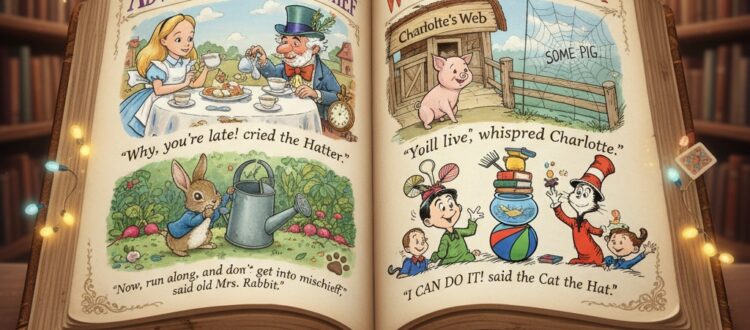From Sketch to Story: Top 10 Legendary Children’s Book Illustrators
Children’s Day is just around the corner — celebrated on November 14 in India and November 20 worldwide — a time to honour the wonder, imagination, and joy of childhood. What better way to celebrate than by shining a spotlight on the brilliant and famous children’s book illustrators who transformed how we see children’s books?
Through their witty drawings, creative character designs, and magical storytelling, these artists made reading not just an activity but an adventure. These children’s book illustrations turned pages into portals and stories into lifelong memories — reminding us that sometimes, a single picture can capture more magic than a thousand words.
Children’s books are more than just stories; they are portals to fantastical worlds, lessons in empathy, and often, a child’s very first introduction to art. From Beatrix Potter’s illustrations of Peter Rabbit to Arthur Rackham’s art, to Maurice Sendak’s book ‘Where the Wild Things Are’, and many others, it’s the illustrations that truly bring these tales to life, captivating young imaginations and leaving an indelible mark on their developing minds. A picture truly is worth a thousand words, especially in the realm of children’s literature, where vibrant visuals can transform a simple story into an unforgettable experience.

Also Read: Rare Books with Illustrations
What Makes a Good Children’s Book Illustration
- Develops Curiosity and Imagination
A good illustration is one that not only brings the story to life but also cultivates curiosity and imagination in young readers’ minds.
- Understand the Story
A good illustration makes it easier and fun to understand what the story is trying to convey.
- Consistency and Flow
The visual tone must stay consistent across the book. Children rely on continuity to follow a story’s rhythm.
- Emotionally Engaging Characters
The illustrator must bring characters to life. Think of Max from Where the Wild Things Are or Winnie-the-Pooh. Their expressions tell whole stories without a single word.
Children’s Book Illustration Style
Here are some famous illustration styles:
- Watercolour Illustration
Watercolour is perhaps the most timeless children’s book style. The soft hues and dream-like quality that is created with watercolour paintings make them effective for fairy tales and other classic children’s books.
- Ink and Pen Drawings
Used for detailed line work, often in early fairy tales and adventure stories.
- Cartoon Illustration
Highly recognizable and appealing to younger audiences, the cartoon style features thick outlines, expressive characters, and vibrant colours.
- Colour Lithography
Early twentieth‑century colour printing helped enable the Golden Age “gift books,” whose rich plates and saturated palettes captivated readers and collectors alike.
- Acrylics/Oils
These illustrations offer rich, vibrant colours and can create detailed or impressionistic effects.
- Digital Art
Modern techniques allow for incredible versatility in style, colour, and effects.
- Mixed Media Illustration
Blending traditional and digital media, mixed media illustration combines elements like pencil, watercolour, collage, and digital editing.
Top Illustrators That Shaped Popular Children’s Books
Here are the top illustrators who brought the characters and stories to life. These iconic creators redefined how generations of children visualised stories”
- Arthur Rackham (1867–1939)

Most Famous For: “Peter Pan in Kensington Gardens” (1906), “Alice’s Adventures in Wonderland” (1907), “Grimm’s Fairy Tales” (1900), and “Mother Goose: The Old Nursery Rhymes” (1913)
Significance: Arthur Rackham remains one of the most collectible illustrators in history. Known for his hauntingly beautiful pen-and-ink drawings and muted watercolour washes, Rackham brought fantasy to life in unforgettable ways.
Rackham’s work was magical yet unsettling, capturing both the wonder and danger of childhood imagination.
- Beatrix Potter (1866–1943)
Most Famous For: Her own series of “Tales,” including “The Tale of Peter Rabbit” (1902), “The Tale of Squirrel Nutkin,” and “The Tale of Benjamin Bunny.”
Significance: A visionary author and illustrator, Potter’s charming, scientifically accurate watercolours of anthropomorphic animals in English countryside settings established a new standard for picture books. Her ability to infuse her animal characters with distinct personalities and her meticulous attention to detail make her work timeless.
- Ernest H. Shepard (1879-1976)

Most Famous For: “Winnie-the-Pooh” (1926) and “The House at Pooh Corner” (1928) by A.A. Milne; “The Wind in the Willows” (1931 edition) by Kenneth Grahame.
Significance: Shepard’s delicate ink line drawings turned Milne’s Winnie-the-Pooh into living magic.
In The Wind in the Willows, Shepard brought to life Mole, Rat, Badger, and Toad, giving animal characters human gestures and charm without losing their natural grace.
- John Tenniel (1820-1914)
Most Famous For: “Alice’s Adventures in Wonderland” (1865) and “Through the Looking-Glass” (1871) by Lewis Carroll.
Significance: John Tenniel’s intricate woodcut illustrations are the definitive visual interpretation of Alice’s fantastical journey. His precise, slightly surreal, and iconic depictions of characters like the Mad Hatter, the Cheshire Cat, and the Queen of Hearts are ingrained in popular culture.
- Maurice Sendak (1928-2012)
Most Famous For: His own books, notably “Where the Wild Things Are” (1963), “In the Night Kitchen” (1970), and “Outside Over There” (1981).
Significance: Few illustrators redefined children’s books like Maurice Sendak. Sendak’s art captured the messy truth of childhood — the tantrums, dreams, fears, and imagination that adults often overlook. His monsters weren’t villains; they were emotions personified.
- Dr. Seuss (Theodor Seuss Geisel) (1904-1991)

Most Famous For: His own extensive collection of books, including “The Cat in the Hat” (1957), “Green Eggs and Ham” (1960), “How the Grinch Stole Christmas!” (1957), and “The Lorax” (1971).
Significance: Dr Seuss’s wildly imaginative, often whimsical, and instantly recognizable illustrations are synonymous with his playful rhymes. In The Cat in the Hat (1957), Green Eggs and Ham (1960), and How the Grinch Stole Christmas! (1957), his surreal characters are instantly recognizable. His quirky shapes, looping lines, and bright colours mirrored his rhythmic, rhyming text.
- Edmund Dulac (1882–1953)
Most Famous For: The Arabian Nights (1907), The Sleeping Beauty and Other Fairy Tales (1910), and Stories from Hans Christian Andersen (1911).
Significance: Influenced by Orientalism and Art Nouveau, Dulac’s art shimmered with fantasy and sophistication.
Dulac’s work elevated book illustration to fine art. His limited-edition prints, often hand-signed, are prized collectibles.
- Garth Williams (1912-1996)
Most Famous For: “Charlotte’s Web” (1952) and “Stuart Little” (1945) by E.B. White; the “Little House on the Prairie” series by Laura Ingalls Wilder; and “Mister Dog” by Margaret Wise Brown.
Significance: Garth Williams possessed a remarkable ability to capture the innocence, humour, and spirit of animals and children. His gentle, yet expressive, pen-and-ink drawings are full of warmth and personality, bringing to life some of the most beloved characters in American children’s literature.
- Mary Shepard (1909–2000)
Most Famous For: Mary Poppins series
Mary Shepard carried on her father, E.H. Shepard’s artistic legacy while carving her own niche with the Mary Poppins series by P.L. Travers.
Significance: Her illustrations balanced realism and fantasy — Mary Poppins floating with her umbrella, the children’s wide-eyed wonder, the charm of London rooftops. She captured the subtle magic that existed within the ordinary, reinforcing the idea that enchantment can live in everyday life.
- Jessie Willcox Smith (1863-1935)
Most Famous For: Illustrations for “A Child’s Garden of Verses” by Robert Louis Stevenson, “Little Women” by Louisa May Alcott, and classic editions of “Cinderella” and “Mother Goose.”
Significance: Smith was one of the most prominent American illustrators of children and domestic scenes during the early 20th century. Her tender, idealized portrayals of childhood, often rendered in soft watercolours and pastels, graced countless books and magazine covers. Her beautiful, sentimental style made her a household name, and first editions of her exquisitely illustrated classics are highly sought after.
Why These Illustrators Became Famous
Each of these artists achieved fame for a combination of artistry, timing, and innovation.
- They pushed boundaries of what children’s illustration could be — from Rackham’s eerie fairylands to Seuss’s surreal humour
- They captured universal emotions through characters that transcended words
- They merged art and storytelling, proving that a picture book could be as meaningful as a novel.
Ultimately, they became famous because they didn’t just draw pictures — they shaped how generations see stories.
Conclusion: The Lasting Magic of Illustrated Books
Children’s book illustrations are not just charming visuals. They are cultural artefacts — windows into imagination, history, and artistry.
Whether you’re a parent, an art lover, or a book collector, illustrated children’s books offer something rare: a fusion of innocence, creativity, and craftsmanship that stands the test of time.
From Beatrix Potter’s watercolour worlds to Maurice Sendak’s wild things, each stroke of colour carries a story that continues to inspire both readers and artists.






